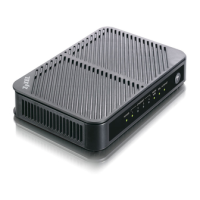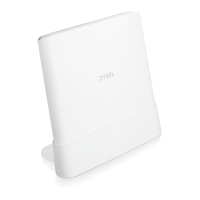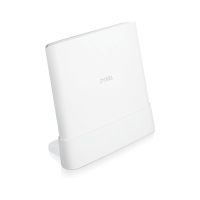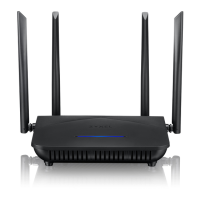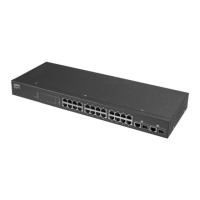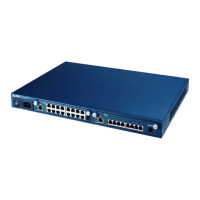Chapter 8 Broadband
VMG/EMG/AM/DM/GM Series User’s Guide
205
Bitswap Select Enable to allow the Zyxel Device to adapt to line changes when you are using G.dmt.
Bit-swapping is a way of keeping the line more stable by constantly monitoring and redistributing
bits between channels.
SRA Enable or disable Seamless Rate Adaption (SRA). Select Enable to have the Zyxel Device
automatically adjust the connection’s data rate according to line conditions without
interrupting service.
DSL Modulation
PTM over ADSL : Select Enable to use PTM over ADSL. Since PTM has less overhead than ATM, some ISPs use this for
better performance.
G.dmt ITU G.992.1 (better known as G.dmt) is an ITU standard for ADSL using discrete multitone
modulation. G.dmt full-rate ADSL expands the usable bandwidth of existing copper telephone
lines, delivering high-speed data communications at rates up to 8 Mbit/s downstream and 1.3
Mbit/s upstream.
G.lite ITU G.992.2 (better known as G.lite) is an ITU standard for ADSL using discrete multitone
modulation. G.lite does not strictly require the use of DSL filters, but like all variants of ADSL
generally functions better with splitters.
T1.413 ANSI T1.413 is a technical standard that defines the requirements for the single asymmetric
digital subscriber line (ADSL) for the interface between the telecommunications network and
the customer installation in terms of their interaction and electrical characteristics.
ADSL2 It optionally extends the capability of basic ADSL in data rates to 12 Mbit/s downstream and,
depending on Annex version, up to 3.5 Mbit/s upstream (with a mandatory capability of ADSL2
transceivers of 8 Mbit/s downstream and 800 kbit/s upstream).
Annex L Annex L is an optional specification in the ITU-T ADSL2 recommendation G.992.3 titled Specific
requirements for a Reach Extended ADSL2 (READSL2) system operating in the frequency band
above POTS, therefore it is often referred to as Reach Extended ADSL2 or READSL2.The main
difference between this specification and commonly deployed Annex A is the maximum
distance that can be used. The power of the lower frequencies used for transmitting data is
boosted up to increase the reach of this signal up to 7 kilometers (23,000 ft).
ADSL2+ ADSL2+ extends the capability of basic ADSL by doubling the number of downstream channels.
The data rates can be as high as 24 Mbit/s downstream and up to 1.4 Mbit/s upstream
depending on the distance from the DSLAM to the customer's premises.
Annex M Annex M is an optional specification in ITU-T recommendations G.992.3 (ADSL2) and G.992.5
(ADSL2+), also referred to as ADSL2 M and ADSL2+ M. This specification extends the capability of
commonly deployed Annex A by more than doubling the number of upstream bits. The data
rates can be as high as 12 or 24 Mbit/s downstream and 3 Mbit/s upstream depending on the
distance from the DSLAM to the customer's premises.
VDSL2 VDSL2 (Very High Speed Digital Subscriber Line 2) is the second generation of the VDSL standard
(which is currently denoted VDSL1).VDSL2 is defined in G.993.2.
G.fast G.fast (Fast Access to Subscriber Terminals) is a DSL protocol standard where the letter G stands
for the ITU-T G series of recommendations. G.fast is a technology providing Gigabit speeds over
traditional copper twisted-pair wires. G.fast applies Fiber-To-The-distribution point (FTTdp)
structure, which reuses the deployed copper wire for the final meters.
VDSL Profile
VDSL2 profiles differ in the width of the frequency band used to transmit the broadband signal. Profiles that use a
wider frequency band can deliver higher maximum speeds.
8a, 8b, 8c, 8d,
12a, 12b, 17a,
30a, 35b US0
The G.993.2 VDSL standard defines a wide range of profiles that can be used in different VDSL
deployment settings, such as in a central office, a street cabinet or a building.
The Zyxel Device must comply with at least one profile specified in G.993.2. but compliance with
more than one profile is allowed.
Cancel Click Cancel to return to the previous configuration.
Apply Click Apply to save your changes back to the Zyxel Device.
Table 42 Network Setting > Broadband > Advanced (continued)
LABEL DESCRIPTION
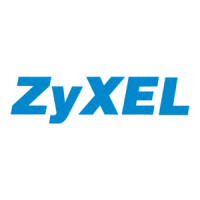
